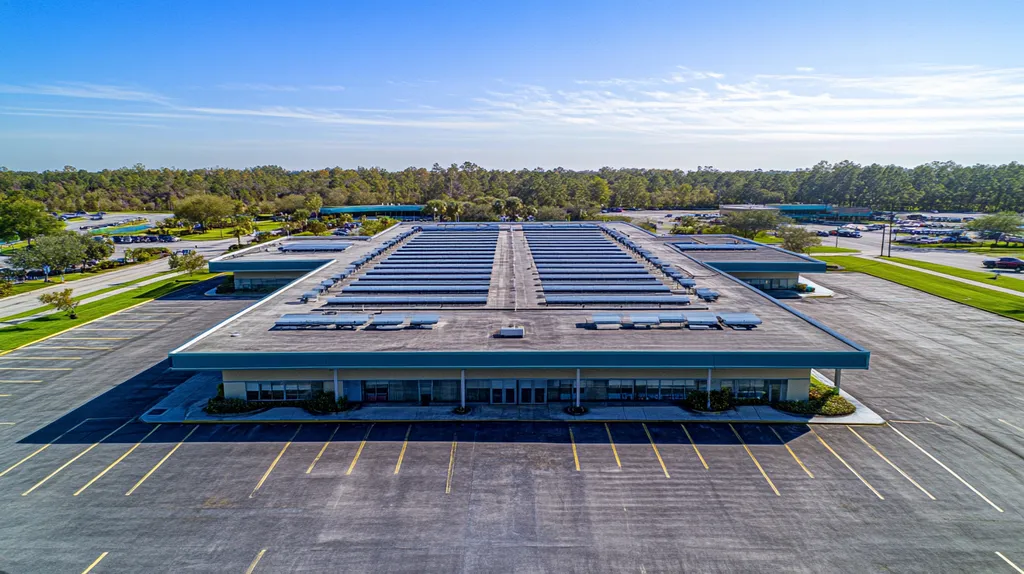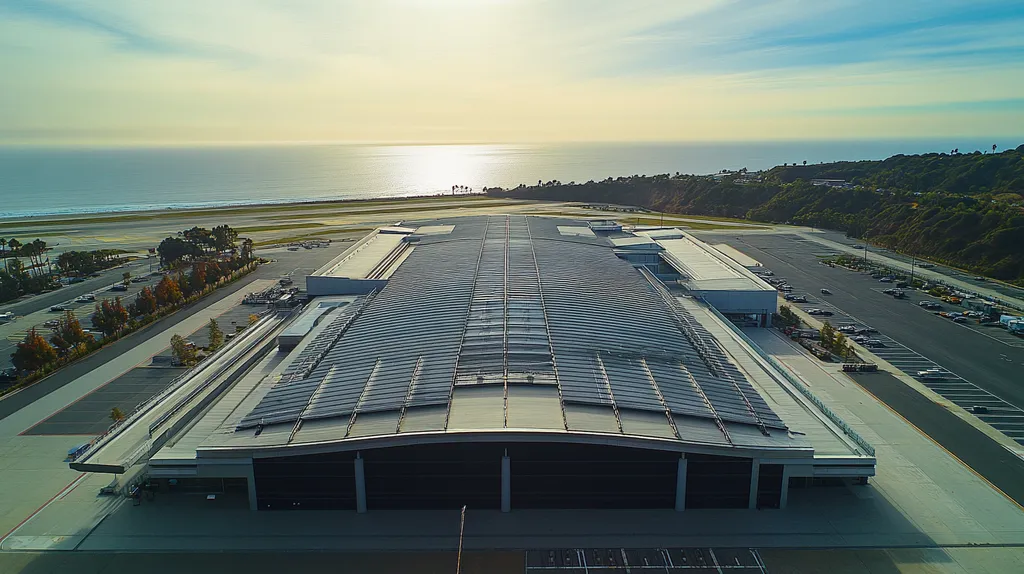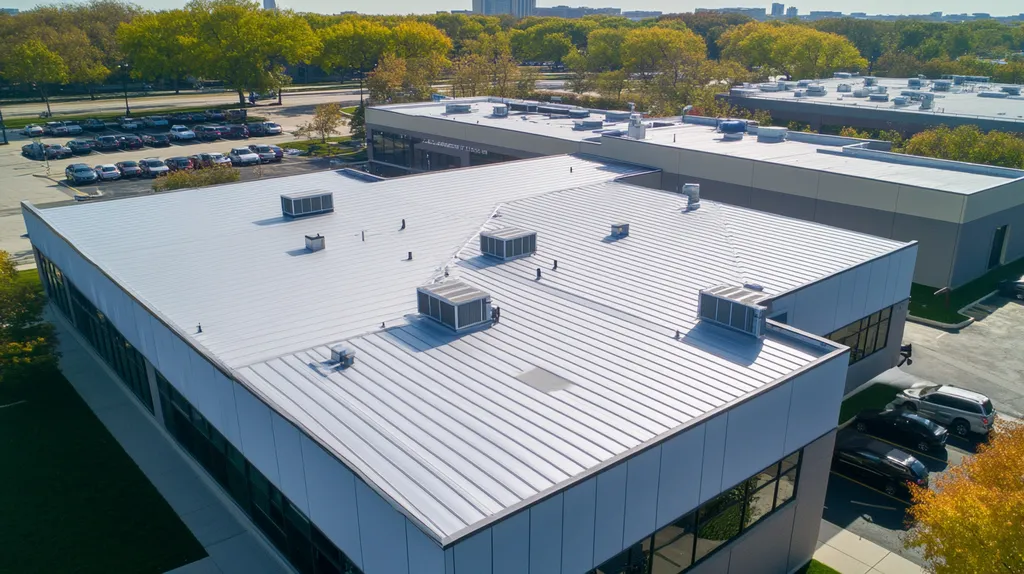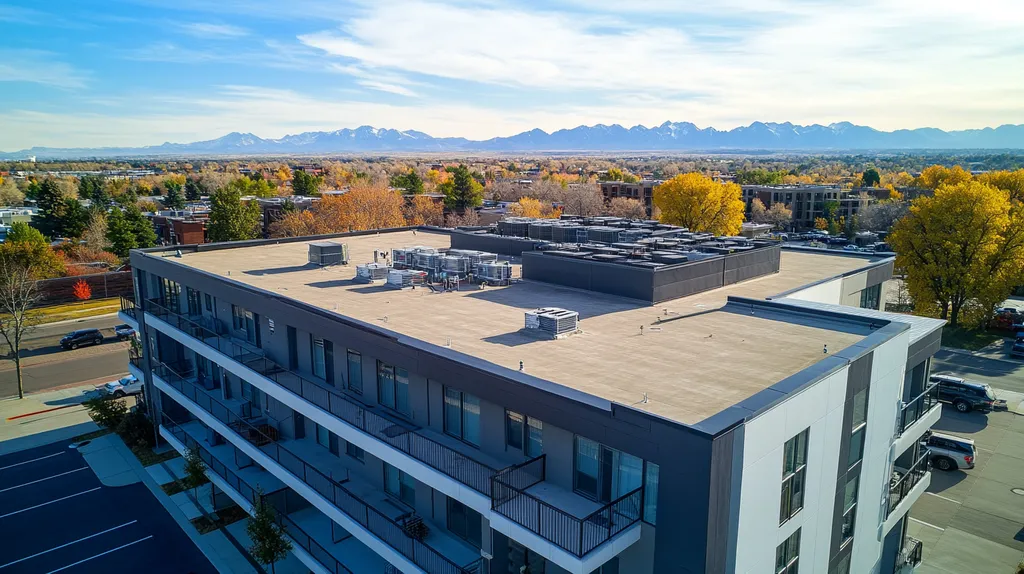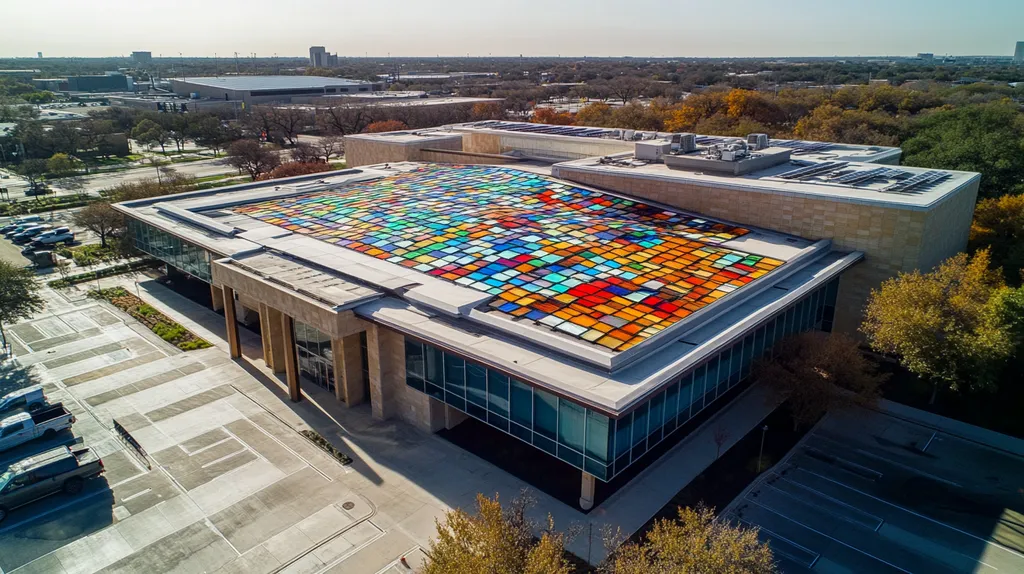The surge in commercial solar installations has created an urgent need to address a critical safety concern: wind resistance. Industry data shows that improperly secured panels can lead to catastrophic failures, with damages exceeding $2 million per incident.
Despite advances in solar technology, misconceptions about wind resistance continue to plague the commercial roofing sector, putting both investments and safety at risk.
This comprehensive analysis separates fact from fiction, examining mounting systems, maintenance challenges, and evidence-based solutions that protect solar installations from wind damage while ensuring optimal performance.
SECTION 1: COMMON MISCONCEPTIONS
The commercial roofing industry is plagued by critical misconceptions regarding the wind resistance of solar panels. As rooftop solar installations surge, it becomes crucial to understand what these panels can truly endure. Reports indicate that improper installations can result in damages and energy losses amounting to millions of dollars. By addressing these misunderstandings, property owners and facility managers can make better-informed decisions regarding their roofing systems and sustainable energy investments.
Solar Panels Can’t Withstand High Winds
A widespread belief is that solar panels are easily damaged by high winds. In fact, modern solar panels are typically designed for impressive durability and can withstand substantial wind loads. For example, panels made for hurricane-prone regions undergo rigorous testing to endure gusts over 150 mph.
This fallacy often stems from outdated models or subpar installation practices that did not guarantee stability. Such past failures do not reflect the resilience of today’s advanced technologies. Innovations in materials and design have led to a new generation of solar panels boasting impressive wind resistance ratings.
Overlooking the true strength of solar panels can foster unnecessary fear and reluctance to pursue property upgrades. This misconception may discourage potential investors from embracing renewable energy solutions that could drive long-term savings and ecological benefits.
It’s essential for facility managers and property owners to consult with qualified professionals who can evaluate their specific environments. A clear understanding of the wind resistance capabilities of installed systems not only ensures safety but also maximizes energy production.
All Mounting Systems Are Equal
The notion that all mounting systems for solar panels are the same is misleading. There is a wide range of mounting systems, each with different wind resistance capabilities shaped by their design, materials, and installation techniques. For instance, while ballasted mount systems are popular, they may not perform as effectively in high-wind areas compared to anchored systems.
Proper installation practices significantly impact wind resistance as well. Mounts that are inadequately secured or improperly placed can lead to devastating failures during storms. Conversely, high-quality mounting systems tailored for wind resistance can substantially enhance the reliability of solar installations.
For property owners, it is crucial to prioritize selecting a mounting system that aligns with both their roofs and local weather conditions. Misunderstanding these differences can undermine panel integrity and overall safety.
Engaging skilled roofing contractors who grasp the intricacies of mounting options will ensure effective installations. Taking this proactive approach fortifies investments in renewable energy, leading to improved performance and reliability.
Wind Resistance Is Not a Priority
Some owners underestimate the significance of wind resistance when planning solar panel installations, a lapse that can have dire consequences for long-term performance and financial returns. Research shows that inadequate wind resistance may result in system failures and costly repairs.
Pitting initial cost savings against potential future expenses by ignoring wind resistance may seem appealing, but it often leads to higher expenditures in the long run. Damage to solar panels can disrupt energy production and precipitate revenue losses, nullifying any anticipated savings from solar investments.
Additionally, neglecting wind resistance can jeopardize compliance with local regulations, as improperly assessed systems may fail to meet required standards. Property owners should consult experienced contractors to ensure systems adhere to local regulations and requirements.
Ultimately, prioritizing wind resistance safeguards investments and enhances the overall efficiency and longevity of solar installations. Staying informed about these crucial factors is vital for maximizing the benefits of solar energy in commercial roofing applications.
SECTION 2: PRACTICAL IMPLICATIONS
The incorporation of solar panels on commercial roofs is now standard practice, but ignoring their wind resistance can lead to severe repercussions. Improper mounting and design challenges can result in panel dislocation, reduced energy production, and even unsafe conditions. With wind-related failures costing property owners thousands in repairs, grasping the implications of wind resistance is crucial. This section explores its impact on panel performance, potential safety hazards from incorrect installations, and the maintenance hurdles that may arise.
Impact on Panel Efficiency and Stability
The efficiency of solar panels can drastically decrease if they are not secured adequately against wind forces. Wind can create uplifting and shear stresses, potentially misaligning or detaching panels, which directly reduces their energy output. For instance, studies demonstrate that panels improperly mounted in high-wind regions can lose up to 40% of their operational efficiency compared to those installed with appropriate wind resistance measures.
In addition, instability caused by wind forces can lead to increased wear and tear on solar systems. Regular exposure to such conditions can shorten the lifespan of a solar installation, ultimately making it less cost-effective. This reality emphasizes the importance of proper wind load assessments during installation.
Investing in effective mounting solutions like ballasted systems or corner reinforcements can greatly enhance panel stability and longevity. By prioritizing sound design considerations, facility managers can ensure their solar systems perform optimally under varied wind conditions.
Ultimately, the stakes are high regarding wind resistance; poorly mounted systems impact financial returns and can cause extensive downtime when repairs or replacements are necessary.
Safety Hazards from Improper Mounting
Improperly mounted solar panels can create significant safety risks for both building occupants and the surrounding environment. Wind events can dislodge unsecured panels, transforming them into dangerous projectiles. Reports have indicated that inadequately installed systems were key factors in accidents during storms, leading to injuries and property damage.
The liability for damages caused by falling panels typically falls on building owners and facility managers. This reality underscores the urgent need for comprehensive assessments of wind resistance before installation. Adhering to best practices and local building codes not only provides protection but also helps to mitigate potential legal liabilities.
Conducting thorough structural evaluations along with installing reinforced mounting solutions can significantly decrease the chances of panel dislocation during adverse weather. Incorporating safety features into solar panel designs adds an extra layer of protection, ensuring the safety of all building occupants.
In summary, neglecting wind resistance has implications that extend far beyond property damage; it directly affects the safety of individuals and increases legal liabilities for property owners.
Maintenance and Repair Challenges
The ongoing upkeep and repairs of solar panels can become increasingly complicated if they are not designed with wind resistance in mind. Frequent dislocations caused by wind can result in ongoing disruptions to energy supply, leading to elevated operational costs. Facilities that deal with repeated panel failures may find their maintenance budgets strained, necessitating more frequent inspections and repairs.
Furthermore, panels requiring constant adjustments or replacements create logistical challenges during maintenance periods. Scheduling repairs can lead to downtime, resulting in lost revenue opportunities for property owners, especially in industries dependent on uninterrupted power supply.
Implementing robust wind resistance measures from the outset can significantly reduce ongoing maintenance efforts. By selecting high-quality mounting systems and adhering to proper installation techniques, facility managers can decrease the need for repairs and enhance overall system reliability.
In conclusion, addressing wind resistance is not a one-time consideration; it has long-term ramifications that affect maintenance costs and operational reliability. Being proactive about preparedness can lead to smoother operations and a more predictable maintenance schedule, ultimately benefiting the bottom line.
SECTION 3: COST OF MISINFORMATION
The stakes are incredibly high when assessing the wind resistance of solar panels on commercial roofs. Property owners and facility managers often underestimate the financial impact of misinformation, leading to costly mistakes. The National Renewable Energy Laboratory reports that incorrectly installed solar panels can incur damage costs reaching thousands of dollars, further straining already tight budgets. Understanding the ramifications of misinformation is crucial to preventing such pitfalls and protecting investments.
Financial Losses from Damaged Panels
The financial repercussions of damaged solar panels can accumulate rapidly. If panels lack the necessary durability to withstand strong winds, they become vulnerable to severe damage. For instance, wind gusts exceeding 90 mph can easily dislodge inadequately secured panels, sometimes resulting in replacement expenses exceeding $15,000 depending on the installation size.
These financial implications extend beyond just replacement costs. When energy production ceases due to damaged panels, businesses relying on solar energy can face significant revenue losses, especially those using clean energy to offset operational costs.
Moreover, the presence of damaged or improperly functioning panels can decrease property values. A roof with neglected solar systems can deter potential buyers or tenants, exacerbating financial losses. Property owners must therefore thoroughly validate the wind resistance claims from their solar panel manufacturers.
In summary, misinformation about wind resistance can lead to substantial financial drains, impacting both immediate budgets and long-term property investments.
Increased Maintenance and Repair Costs
The potential for increased maintenance and repair costs is another critical issue arising from misinformation. Solar panels that do not meet wind resistance regulations are far more likely to require frequent repairs. Property managers may find themselves facing ongoing inspection costs and recurrent repairs to rectify wind-related damages.
Over time, these expenses can build up quickly. For example, added maintenance visits might cost hundreds of dollars each, transforming what should be a reliable solar installation into a financial burden. Facility teams could find themselves expending valuable time and resources to monitor the system’s integrity.
Additionally, if a panel fails, the repair process can become far more complex. Costs for scaffolding, crane rentals, and specialized labor can inflate expenses, severely straining maintenance budgets and diverting funds from other essential repairs.
Ultimately, neglecting to ensure proper wind resistance from the outset creates a cycle of rising costs. Thus, property owners must prioritize accurate assessments of wind resistance to safeguard their investments.
Potential Liability and Insurance Issues
Potential liability and insurance concerns present another significant risk linked to misinformation. When solar panels lack wind resistance, any resultant damage could place property owners at risk for liabilities. Should a panel detach during a storm and damage surrounding property or injure someone, the fallout could be severe.
Insurance companies often scrutinize claims related to poorly installed systems. Denial of claims due to non-compliance with industry standards could force property managers to bear the costs of repairs and even face legal challenges. This unpredictability in insurance coverage is a serious threat to commercial roofing investments.
Moreover, failing to comply with wind resistance codes can lead to increased insurance premiums. Insurers frequently raise rates for businesses categorized as high-risk, placing further financial strain on operational costs. This pressure may affect decisions related to future roofing projects or facility updates.
To mitigate these risks, facility managers must perform thorough research and work with qualified professionals. Adhering to wind resistance standards protects both investments and minimizes liability for property owners.
SECTION 4: REALITY CHECK
The wind resistance of solar panels on commercial roofs isn’t just a technicality; it plays a critical role in ensuring both the longevity and safety of roofing structures. With over 25% of commercial buildings exposed to high winds, grasping local regulations and requirements is essential. Property owners and facility managers must actively engage with these factors to protect their investments and adhere to safety standards.
Local Wind Load Requirements and Regulations
Local building codes define specific wind load requirements crucial for roofing systems. These regulations help ensure roofs can withstand the forces generated by high winds. For instance, buildings in hurricane-prone areas must comply with much stricter wind load criteria than those in calmer regions.
Failing to follow these regulations can have severe consequences. Property owners could face legal liabilities if panels become dislodged during storms, potentially leading to injuries or property damage. Thus, it’s vital for facility managers to fully understand these regulations and collaborate with roofing professionals throughout the installation process.
Furthermore, wind load requirements can differ significantly over short distances. What meets local standards in one municipality might not be adequate just a few miles away. Therefore, engaging with local building authorities is essential to ensure compliance.
Investing time to understand local regulations can prevent complications down the line and create a safer environment for all building occupants.
Regional Variations in Wind Speeds
Wind speeds can vary greatly across different geographic areas. Coastal regions often experience stronger winds compared to inland locations, which generally see less intense gusts. Recognizing these regional characteristics is vital in designing effective solar panel installations.
For example, facility managers in Florida must account for higher wind speeds when planning installations compared to their counterparts in Ohio. Utilizing regional data aids in making informed decisions about the types of mounting systems and overall infrastructure needed for solar panels.
Ignoring local wind patterns can result in inadequate installations. Panels that are improperly secured may sustain damage during storms, necessitating costly repairs and operational disruptions. As such, thorough regional assessments are critical for ensuring optimal performance and safety.
Consequently, property owners should prioritize detailed evaluations specific to their location to effectively incorporate wind resistance into their solar installations.
Importance of Site-Specific Assessments
Site-specific assessments are essential for understanding wind behavior around a structure. Elements such as building height, nearby structures, and landscaping can significantly affect prevailing wind patterns. Relying solely on generalized wind speed data is insufficient for making accurate evaluations.
For instance, a tall building surrounded by shorter structures may experience wind channeling effects, resulting in heightened localized wind speeds. Conducting thorough assessments is vital to ensure the safety and effectiveness of solar panel systems.
Investing in specialized wind load analysis tailored to the site can lead to installations that perform better and enhance safety. Expert evaluations can pinpoint potential vulnerabilities and suggest solutions specific to each property.
Ultimately, prioritizing site-specific evaluations allows property owners and facility managers to make informed decisions, optimizing wind resistance for solar panels and ensuring long-term performance and safety.
SECTION 5: EVIDENCE-BASED ALTERNATIVES
With the increasing adoption of solar panels in commercial properties, ensuring their resilience to wind is more critical than ever. Insufficient wind resistance not only jeopardizes solar installations but can also lead to staggering repair costs and potential liabilities. Research indicates that roofs lacking thorough wind assessments face failures that can accumulate to over $100 million in damages annually across the U.S. To avoid these pitfalls, facility managers should explore aerodynamic designs, durable materials, and robust anchoring systems that enhance both safety and longevity of solar installations.
Aerodynamic Design for Wind Resistance
Wind exerts powerful forces on solar panel arrays, making an aerodynamic design essential. Solar panels engineered with streamlined contours reduce wind resistance and improve overall stability. Research reveals that such panels can endure gusts of up to 140 miles per hour when correctly designed.
Utilizing lower-profile mounts minimizes the surface area that faces the wind, thereby diminishing lifting forces. This design feature is particularly vital for installations in regions prone to high winds, where building codes enforce strict performance guidelines.
Furthermore, carefully considering the placement of panels can optimize airflow, allowing winds to pass beneath the system more freely. This optimization enhances the panels’ performance and extends the lifespan of both the solar technology and the roofing material.
By prioritizing aerodynamic designs, commercial property owners significantly reduce risks while safeguarding their investments in solar energy technology.
High-Quality Materials for Durability
The materials selected for solar panel systems play a pivotal role in their capacity to endure wind stresses. Utilizing high-quality, weather-resistant materials is vital for achieving durability and reliable performance in extreme conditions. For example, tempered glass and sturdy aluminum frames provide excellent resistance against wind forces.
Additionally, corrosion-resistant coatings protect against environmental wear, ensuring that both the panels and their mounts last longer. This consideration is especially critical in coastal regions, where saltwater can accelerate material degradation.
Certifications from recognized organizations can verify the quality of the materials used, affirming that they meet important industry standards for wind resistance. Though investing in superior materials may incur higher upfront costs, the savings in repairs and replacements will be substantial in the long run.
By focusing on durable materials, facility managers can develop solar installations that stand resilient against harsh environmental conditions.
Reinforced Anchoring Systems for Stability
The anchoring system is a vital element that impacts the overall stability of solar panel configurations. A high-performance anchoring system secures panels firmly to the roof, significantly reducing the risk of dislodgment during high winds. Yet, many facility managers underestimate the importance of superior anchor systems.
Utilizing reinforced anchors built to withstand extreme weather can transform a solar installation’s stability. For instance, employing stainless steel anchors alongside durable adhesives greatly enhances holding strength compared to standard anchors.
Implementing a grid layout for distributing wind loads evenly across the roof further strengthens structural integrity. This method minimizes localized stress, which often leads to panel detachment or roof damage.
In summary, investing in sophisticated anchoring systems enhances the wind resistance of solar panel installations, effectively protecting both assets and solar investments against unpredictable weather events.
SECTION 6: TEST AND VERIFY
The wind resistance of solar panels is not just a technical detail; it’s a critical factor that could determine the success or failure of an installation. Inadequate testing and verification can lead to catastrophic outcomes, from damaged panels to compromised safety. Studies reveal that improperly secured solar panels can become dislodged during high winds, leading to extensive property damage and safety risks. This section outlines the essential steps to ensure that mounting systems effectively resist wind forces, comply with local regulations, and undergo rigorous testing.
Conducting Thorough Site Assessments
Thorough site assessments are the foundation of any effective solar panel installation. Each commercial structure has unique characteristics, including height, surrounding buildings, and type of roof, all of which influence wind behavior. A meticulous assessment evaluates these factors to determine the most suitable placement and mounting for solar panels.
Key elements like rooftop wind speeds and potential obstructions need careful analysis. This information aids in identifying the optimal orientation and securement methods for the panels. Neglecting these assessments can lead to unforeseen challenges that necessitate costly reworks down the line.
Collaborating with certified roofing professionals is essential during this phase. Experienced experts can pinpoint risks and provide solutions tailored to the specific environment. Investing time in these evaluations safeguards the roof and the solar investment.
In summary, comprehensive site assessments are crucial for protecting solar panels from wind forces, ultimately enhancing the performance, durability, and longevity of the system.
Compliance with Local Building Codes
Adhering to local building codes is non-negotiable for any roofing endeavor, particularly when installing solar panels. These codes outline critical safety and performance standards, which can vary widely by jurisdiction. Understanding and complying with these requirements is essential to ensure that the system can withstand local wind conditions.
For example, specific wind load requirements in certain areas may directly influence the design and installation of mounting systems. Non-compliance can result in severe penalties and, more importantly, significant safety risks during extreme weather.
It’s vital for property owners and facility managers to ensure their contractors are knowledgeable about and compliant with local building regulations. Collaborating with licensed professionals who adhere to these codes ensures a secure and reliable installation.
Ultimately, compliance enhances safety and protects the investment, facilitating the process of obtaining necessary permits and avoiding future legal complications.
Testing and Certification of Mounting Systems
Never overlook the importance of testing and certification for mounting systems. These procedures confirm that mounting systems can withstand anticipated wind forces specific to the installation site. Certified systems provide an added layer of assurance, contributing significantly to long-term efficacy and safety.
Standards set by organizations like the American Society for Testing and Materials (ASTM) outline how mounting systems should endure pressure. Investing in certified products lessens risks associated with inadequate materials or faulty installation.
Facility managers should demand documentation from manufacturers regarding the testing processes for mounting systems. This transparency provides confidence in the quality of materials and designs utilized.
Regular inspections and maintenance further reinforce the integrity of the installed systems. Ongoing evaluations allow for timely repairs or adjustments, extending the lifespan of both the solar array and the roof.
In conclusion, thorough testing and certification processes are vital for promoting safety and effectiveness in solar panel installations. Compliance in these areas not only protects investments but also enhances overall building integrity.
The Bottom Line
With solar panel failures costing the commercial sector over $100 million annually, wind resistance can no longer be treated as an afterthought in rooftop installations.
The evidence clearly demonstrates that proper wind resistance measures, including aerodynamic design and reinforced mounting systems, can protect installations from gusts exceeding 140 mph.
Site-specific assessments, compliance with local building codes, and certified mounting systems form the foundation of safe, reliable solar installations.
The commercial roofing industry must embrace these evidence-based practices to safeguard the estimated $25 billion in solar investments projected for 2024.
The path forward requires rigorous testing, verified materials, and unwavering commitment to wind resistance standards that protect both assets and lives.
FREQUENTLY ASKED QUESTIONS
Q. Can commercial roofs support solar panels in high wind areas?
A. Yes, modern solar panels are designed to endure strong winds when properly installed. It’s crucial to use appropriate mounting systems and consult professionals familiar with local wind conditions for optimal performance.
Q. What wind resistance measures should facility managers consider?
A. Facility managers should prioritize selecting high-quality mounting systems, conducting wind load assessments, and incorporating aerodynamic designs. Investing in these factors enhances the safety and performance of solar installations against wind forces.
Q. How does misinformation about commercial roofs impact solar panel installations?
A. Misinformation can lead to inadequate installations that compromise safety and efficiency, resulting in costly repairs and potential legal liabilities. It’s essential for property owners to validate information regarding wind resistance before installation.
Q. What are the local wind load requirements for industrial roofs?
A. Local wind load requirements can vary significantly based on geographic location and building codes. Property owners should consult local regulations to ensure their installations comply with these standards for safety and durability.
Q. How can facility managers ensure solar panel durability against wind?
A. Facility managers can enhance durability by using high-quality materials, choosing aerodynamic designs, and employing reinforced anchoring systems. These steps are critical to withstand wind forces and extend the lifespan of the installations.
Q. What testing is required for wind resistance of solar panels?
A. Testing should include site assessments and verification of mounting systems’ compliance with local building codes. Certification ensures that the systems will perform under expected wind conditions, enhancing safety and reliability.
Q. What long-term impact does wind resistance have on solar panel performance?
A. Proper wind resistance is crucial for maintaining energy efficiency and system uptime. Over time, ignoring these considerations can lead to increased repair costs, reduced lifespan, and ultimately, financial losses for property owners.

